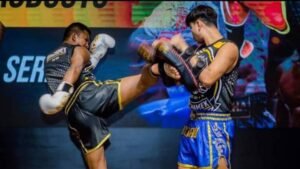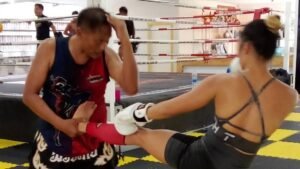Introduction: The Art of Muay Thai
Muay Thai, often referred to as “The Art of Eight Limbs,” stands out in the world of martial arts for its unique and comprehensive combat techniques. Originating in Thailand, Muay Thai has a rich history that dates back centuries, evolving from ancient battlefield tactics. Unlike other martial arts that primarily focus on fists and feet, Muay Thai incorporates eight points of contact—fists, elbows, knees, and shins—making it a highly versatile and effective form of self-defense and competition.
The cultural significance of Muay Thai in Thailand cannot be overstated. It is more than just a sport; it is a symbol of national pride and cultural heritage. Traditional Muay Thai training camps emphasize not only physical strength and agility but also mental toughness and discipline. Fighters often undergo rigorous training regimens that include running, shadowboxing, pad work, bag work, and sparring sessions. This holistic approach to training aims to build resilience, sharpen techniques, and cultivate a fighter’s warrior spirit.
What differentiates Muay Thai from other martial arts is its practicality and effectiveness in real-world scenarios. The strategic use of elbows and knees in close combat scenarios can be particularly destructive, giving fighters a significant edge. Additionally, the sport’s clinch techniques—where fighters grapple to dominate an opponent and deliver powerful knee strikes—are unparalleled in their effectiveness. This blend of striking and grappling renders Muay Thai a formidable martial art both in the ring and for self-defense purposes.
Furthermore, the core philosophies of Muay Thai, which include humility, respect, and perseverance, reflect the sport’s traditional roots. These values are deeply ingrained in the training culture, as fighters are taught to honor their trainers, opponents, and the sport itself. This emphasis on respect and discipline helps maintain the integrity and authenticity of Muay Thai, ensuring its continued reverence and popularity both in Thailand and worldwide.
Fight 1: The Iconic Showdown – Buakaw Banchamek vs. Masato
The legendary fight between Buakaw Banchamek and Masato is etched in Muay Thai history due to its intensity and showcasing of skill. Both fighters came into the bout with formidable reputations. Buakaw Banchamek, renowned for his aggressive, relentless style and powerful techniques, contrasted sharply with Masato, who was celebrated for his strategic, defensive approach.
As the bout commenced, Buakaw’s strategy was apparent—he aimed to dominate with his trademark ferocity and unyielding pace. From the outset, Buakaw pushed forward, utilizing a mix of powerful kicks and swift punches. His relentless aggression aimed to unsettle Masato, who responded with seasoned composure. Masato’s defensive techniques, including precise counters and tactical footwork, were pivotal in navigating Buakaw’s offense.
Key moments in the fight highlighted the contrast between Buakaw’s offensive power and Masato’s resilient defense. In the initial rounds, Buakaw’s aggressive pace set the tone, with his powerful roundhouse kicks and lethal knee strikes imposing a significant challenge for Masato. Despite the onslaught, Masato demonstrated remarkable resilience, employing his defensive skills to absorb and counter Buakaw’s attacks strategically.
The pivotal rounds saw Buakaw intensifying his offense, increasing his tempo and pressure. His combination of striking power and technical proficiency began to overwhelm Masato. Buakaw’s clinch game, where his knees and elbows came into play, further tilted the fight in his favor. Throughout these exchanges, Masato’s defensive posture remained commendable, but the accumulative effect of Buakaw’s relentless assault started to show.
Ultimately, Buakaw’s combination of relentless pace, power, and technical prowess secured his victory. His ability to maintain an aggressive yet controlled approach against a defensively adept opponent like Masato underscored his standing as one of Muay Thai’s elite fighters. This iconic showdown remains a testament to the tactical intricacies and sheer determination inherent in Muay Thai combat.
Fight 2: The Technical Mastery – Samart Payakaroon vs. Dieselnoi Chor Thanasukarn
The legendary encounter between Samart Payakaroon and Dieselnoi Chor Thanasukarn remains one of the most analyzed fights in the history of Muay Thai. This bout is the epitome of technical mastery, showcasing two distinctly different fighting styles. Samart Payakaroon, known for his unparalleled precision and speed, faced Dieselnoi Chor Thanasukarn, a fighter whose height and formidable clinch game set him apart from his contemporaries.
From the outset, Samart’s technique focused on quick, precise strikes. His agility allowed him to move fluidly around the ring, throwing sharp teeps and swift combinations that kept Dieselnoi on edge. Samart’s ability to anticipate his opponent’s movements and strike at the perfect moment demonstrated his high level of technical proficiency.
On the other hand, Dieselnoi leveraged his height advantage and excelled in the clinch, an area where he imposed his dominance. His nickname, “Sky Piercer,” aptly describes the way he utilized his long limbs to deliver devastating knees during the clinch. Dieselnoi’s strategy was to close the distance, neutralizing Samart’s striking range, and bringing the fight into his domain.
Throughout the fight, both fighters made necessary adaptations. Samart attempted to counter Dieselnoi’s clinch supremacy by using his footwork to evade and minimize engagement in close quarters. He periodically achieved success with precise low kicks aiming to destabilize Dieselnoi. However, Dieselnoi’s resilience and constant forward pressure started to tilt the balance.
The critical techniques that granted Dieselnoi the edge were his relentless knee strikes and his ability to control the clinch. Once in the clinch, he managed to utilize his height and leverage to land impactful knees repeatedly. Despite Samart’s best efforts to disengage, Dieselnoi’s clinch game proved too overpowering. His tactical prowess in the clinch ultimately led him to victory, solidifying this match as a quintessential example of contrasting styles and technical mastery in Muay Thai.
Fight 3: The Modern Classic – Saenchai vs. Anuwat Kaewsamrit
In the realm of Muay Thai, few matchups have been as compelling as the bout between Saenchai and Anuwat Kaewsamrit, aptly dubbed a modern classic. This encounter put on display the contrasting styles of two legendary fighters. Saenchai, known for his unorthodox methods and technical prowess, stood in stark contrast to Anuwat’s formidable strength and powerful punches. The fight, rich in major exchanges and strategic maneuvers, highlighted the distinctive skills that have made these athletes revered figures in Muay Thai.
From the outset, Saenchai’s evasive techniques were on full display. His movement around the ring was characterized by fluidity and an almost teasing elegance. Dodging and slipping past Anuwat’s attacks, Saenchai looked to capitalize on his superior footwork. On several occasions during the bout, his agility enabled him to evade Anuwat’s powerful strikes, often just narrowly. Saenchai’s ability to read his opponent’s intentions and adapt was a critical element of his strategy.
While Anuwat attempted to gain the upper hand through sheer force, deploying his raw power and signature hooks, Saenchai’s countering ability proved to be an effective deterrent. Perfectly timed counters from Saenchai not only scored points but also disoriented Anuwat, who was often left swinging at air. These counters, executed with precision, showcased Saenchai’s unparalleled sense of timing. Whether it was a well-placed jab or a deft kick, each move served a purpose in unraveling Anuwat’s more straightforward approach.
As the fight progressed, it became evident that Saenchai’s strategic evasions and calculated responses were wearing down his opponent. Moments where Saenchai would seemingly retreat, only to strike back with unexpected ferocity, exemplified his tactical genius. This mix of defense and offense allowed him to control the pace, ultimately leading to his victory. By leveraging his technical wizardry and unorthodox style, Saenchai not only nullified Anuwat’s raw power but also provided a masterclass in Muay Thai finesse.
Analyzing Key Strategies in Muay Thai
Muay Thai, known as the “Art of Eight Limbs,” is a combat sport with a rich history of strategic intricacies. Among the most notable strategies used by fighters are clinch fighting, sweeps, counterattacks, and meticulous footwork. These tactics not only showcase the sport’s unique blend of power and precision but also highlight its tactical depth.
Clinch fighting is a hallmark of Muay Thai, emphasizing close-range combat where fighters engage using knees, elbows, and sweeps. The clinch is a versatile technique, allowing fighters to control their opponent’s movements and set up for powerful knee strikes. In the legendary bout between Saenchai and Penek, Saenchai’s mastery of the clinch was evident. He utilized the clinch to off-balance Penek, creating opportunities for devastating knee strikes that significantly impacted the match’s outcome.
Sweeps are another fundamental strategy in Muay Thai, often used to disrupt an opponent’s rhythm and gain a tactical advantage. By sweeping an opponent off their feet, a fighter can establish dominance and influence the flow of the match. For instance, in the fight between Sam-A Gaiyanghadao and Sangmanee, Sam-A skillfully executed several sweeps, showcasing his ability to unbalance Sangmanee and effectively control the tempo of the fight.
Counterattacks are a crucial element of Muay Thai, leveraging timing and precision to exploit an opponent’s mistakes. Effective counterattacks require an acute sense of distance and timing. The bout between Buakaw Banchamek and Andy Souwer is a prime example, where Buakaw utilized sharp counterattacks to capitalize on Souwer’s aggressive advances. By timing his strikes perfectly, Buakaw was able to land impactful counters that steered the momentum in his favor.
Footwork, often underestimated, is the foundation upon which all other strategies are built. Superior footwork allows a fighter to maintain balance, evade attacks, and position themselves advantageously. In the celebrated match between Rodtang Jitmuangnon and Jonathan Haggerty, Rodtang’s footwork was instrumental. His ability to move fluidly and evade Haggerty’s strikes while simultaneously setting up his own attacks demonstrated the critical importance of agile and purposeful footwork in Muay Thai.
Through these examples, it is evident that the strategic elements of clinch fighting, sweeps, counterattacks, and footwork are not only integral to Muay Thai but also define the artistry and effectiveness of this revered combat sport.
Technical Breakdown: Signature Moves
Muay Thai, known as the “Art of Eight Limbs,” is rich with diverse techniques and signature moves that have defined many legendary bouts. By delving into specific maneuvers executed by luminaries such as Buakaw, Samart, and Saenchai, we gain a profound understanding of their technical prowess, precision timing, and strategic intent on the grand stage of competitive Muay Thai.
Buakaw’s Devastating Roundhouse Kicks
Buakaw’s roundhouse kicks are a testament to his power and precision. The technique begins with a swift pivot on the supporting foot, enabling a full hip rotation and maximizing the strike’s impact. Timing is key; Buakaw often initiates this move just as his opponent inches closer, rendering them unable to evade. Strategically, these kicks target the torso or thighs, aiming to hinder the opponent’s mobility or guard. A slow-motion analysis reveals that his kicks are not merely about strength; they incorporate balance, speed, and an intricate understanding of human biomechanics.
Samart’s Rapid Counters
Samart Payakaroon is celebrated for his rapid counters, which combine defensive acumen with offensive agility. His counters are characterized by lightning-fast strikes immediately following an opponent’s attack, exploiting openings with surgical accuracy. The mechanics involve an advanced sense of timing and distance management – crucial components in Muay Thai. When breaking down these counters frame-by-frame, it’s evident that Samart’s reflexes and ability to anticipate his opponent’s moves allow him to turn defense into swift, counteroffensive opportunities, often culminating in decisive blows.
Saenchai’s Deceptive Footwork
Saenchai’s footwork stands as a hallmark of his distinctive fighting style, weaving a tapestry of deception and unpredictability. His lateral movements, characterized by quick sidesteps and unpredictable shifts, confound opponents and create openings for strikes. Analyzing his footwork in slow motion, we observe how Saenchai maintains balance while rapidly changing directions, often putting himself in a favorable position to launch unexpected attacks. This deceptive footwork is instrumental in setting up his trademark techniques, such as the cartwheel kick, further emphasizing the strategic layers embedded in his approach to fighting.
Together, these signature moves not only highlight the individual brilliance of Buakaw, Samart, and Saenchai but also showcase the intricate technical and strategic elements that make Muay Thai a profoundly complex martial art. Understanding these techniques through detailed breakdowns provides enthusiasts and practitioners valuable insights into mastering the sport.
Lessons Learned: What Fighters Can Take Away
In the world of Muay Thai, legendary bouts often serve as textbooks for upcoming fighters. They shed light on various crucial aspects that are not just about physical prowess but also encompass mental fortitude, strategic preparation, adaptability, and understanding an opponent’s weaknesses. One of the most significant takeaways for any fighter is the necessity of mental toughness. The ability to stay composed under pressure, maintain focus, and push through adversity can often be the deciding factor between victory and defeat.
Next, the importance of preparation cannot be overstated. Extensive training regimens, including rigorous conditioning, technical drills, and sparring, play a crucial role. Fighters like Buakaw Banchamek and Saenchai are prime examples of athletes who invest countless hours perfecting their techniques and enhancing their stamina. Developing a well-rounded preparation routine that covers all facets of the sport can significantly elevate a fighter’s performance.
Adaptability is another key lesson gleaned from legendary Muay Thai fights. Champions often face unexpected challenges in the ring, and those who can adjust their strategies on the fly tend to come out on top. Studying fights where adaptability was the turning point helps fighters understand different tactical approaches and prepares them to think quickly and effectively during their own matches.
Understanding an opponent’s weaknesses is yet another critical lesson. Analyzing past bouts to identify patterns, vulnerabilities, and tendencies can provide a tactical edge. Fighters such as Samart Payakaroon have demonstrated the importance of exploiting an opponent’s weaknesses, whether through targeted strikes or strategic movements, to gain an upper hand. Developing the skill to study and understand these patterns is invaluable for any fighter.
Incorporating these lessons into training includes mental conditioning exercises, meticulously planned training schedules, sparring sessions that emphasize adaptability, and thorough opponent analysis. By internalizing these elements, fighters can significantly enhance their readiness for competition, steering themselves closer to their own legendary status in the sport of Muay Thai.
Conclusion: The Future of Muay Thai Analysis
The landscape of Muay Thai continues to evolve, fueled by the analysis of famous fights that have marked the sport’s history. Evaluating these legendary matches not only celebrates the achievements of past fighters but also offers invaluable insights into improving contemporary techniques. This analytical approach enables coaches and athletes to refine their strategies, paving the way for the future generation of Muay Thai champions.
The advent of technology plays a pivotal role in enhancing the analysis of Muay Thai fights. Advanced software tools enable detailed breakdowns of fighters’ movements, allowing for the identification of patterns and weaknesses that might not be visible to the naked eye. Techniques such as slow-motion replays and data analytics provide an empirical foundation for devising superior training methods, ultimately leading to a more sophisticated understanding of the sport.
Furthermore, these technological advancements are complemented by increasingly sophisticated training programs. Modern sports science introduces a wide array of methods that contribute to better preparation, recovery, and overall performance. Nutritional plans, mental conditioning, and personalized fitness routines are now integral components of a fighter’s regimen. The blend of traditional Muay Thai principles with contemporary sports science creates a comprehensive approach to training, ensuring that athletes are well-rounded and resilient.
Additionally, the global growth of Muay Thai has expanded the sport’s reach and popularity. As more people across different continents become practitioners and enthusiasts, the cross-cultural exchange of techniques and philosophies enriches the discipline. This global perspective fosters a deeper appreciation and understanding of Muay Thai, highlighting its artistry and complexity. By studying historic fights, new and seasoned fighters alike can grasp the evolution of tactics and styles, gaining inspiration and knowledge from past legends.
In essence, the thorough analysis of iconic Muay Thai fights is more than a retrospective exercise. It is a vital component in the ongoing development of the sport, ensuring that it remains dynamic and ever-improving. As technology advances, training methods become more sophisticated, and the global community of Muay Thai enthusiasts grows, the future of Muay Thai analysis promises to be as storied and impactful as its illustrious past.




